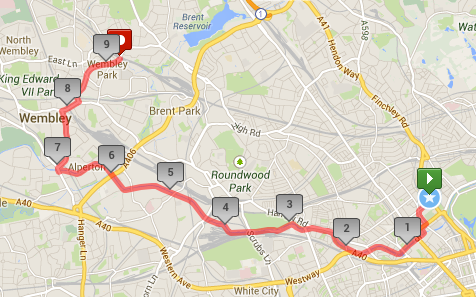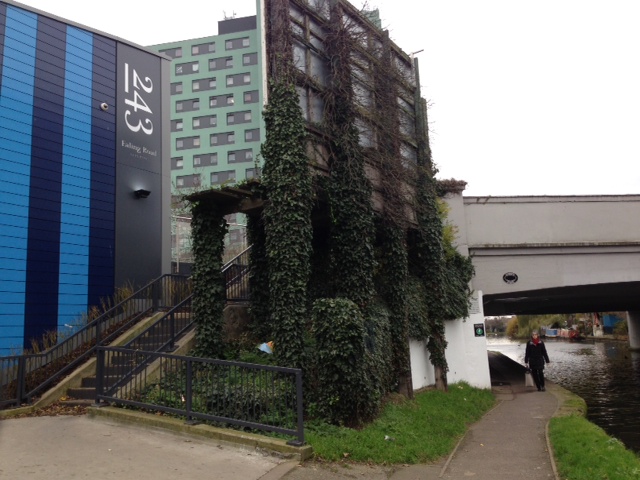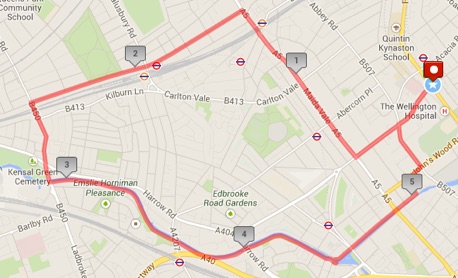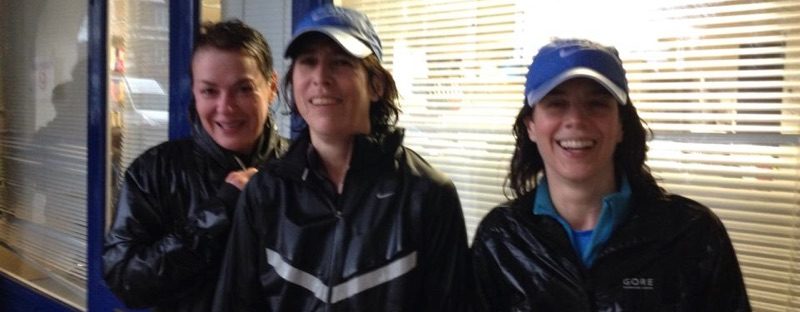Hi Runners!
Welcome back! It was great to see so many of you out and running this week. A special round of “extra credit” for the 25+ women at Barclays on a very dark, dreary, rainy Monday morning. Our reward was a run in the pouring rain, only to return to Starbucks to see the sun come out. Typical. Thanks for laughing with me in the misery. The best part is that we still had a big group stay for coffee even though we were drenched. Nothing messes with the coffee!
I hope with the bad weather, ASL school evacuation and jet lag you managed to get in a bit of running last week. Our training will continue to pick up as we approach the half marathon. We’re officially 11 weeks from the race!
As a reminder, our training is based on three runs per week.
-slow, longer run
-fast/tempo run
-hill run
This week I’d like to focus on the importance of running a slower long run. Below I’ve copied Paula’s explanation from our website. This is important stuff so it is worth the read. (Next week, I’ll review the fast/tempo run so don’t worry, it’s not all about running slowly!) Also please read to the end to see an important announcement about the 10s pace group. This week, the long run is to Wembley. Many women said that they loved this run so we’re doing it again. Plus it will give us a good long uninterrupted run to work on pace.
Why do we run the long run slower than race pace?
The quick answer is that it has to do with how your body builds fuel, which is something you’ll need for the race! I’ll delve into the basic science of fueling (which I have hugely over-simplified but hopefully it’ll get my point across). To fuel our runs we have 3 options – Creatine Phosphate (CP), glycogen and fat.
Creatine Phosphate– You have about 15 seconds worth of CP fuel – that’s it. Think Usain Bolt running the 100m – he fuels with CP and it works because he can run 100m in less than 15 seconds. CP is where your body will go first looking for fuel, particularly if you take off like a rocket from Starbucks. Think of CP as kindling on a fire – it catches fire easily but burns out very quickly.
Glycogen– Glycogen is the next fuel option. Glycogen is basically stored in your muscles and in your liver and because of that it makes glycogen a bit more difficult to burn as fuel (think of damp firewood – it will eventually burn but it takes quite a bit to get it going).
Fat– Fat is the 3rd source of fuel and most runners, even the very lean women, have an ample supply of it. Think of fat as a butane tank of gas on the BBQ grill – once it’s lit, you can have countless cook-outs before the fuel is gone.
Here’s the important part– All of those fuel sources – kindling, damp firewood or butane gas need something to ignite them and keep them burning. Physiologically speaking that ignition or burning “tool” is ATP which is created by mitochondria; so, the more mitochondria you have the more efficient you are as a fuel burning machine.
What is mitochondria and how do we get more of it? Some of us are genetically blessed with higher mitochondria counts. Thank your mother for that – it comes through the maternal side of the genetic equation. If you didn’t win the genetic lottery, then the only way you can increase mitochondria is through LONG, SLOW, ENDURANCE training (LSE). When you go for a long run at a slow pace, you actually produce mitochondria. Kind of cool, huh? Now remember – we need mitochondria to help ignite our fuel sources. So what does that mean for you?????? It means SLOW DOWN on your long run – give your body a chance to become a mitochondria production factory. If you do your long run at a strong pace, you’re missing out on this benefit.
How slow, is slow? On our website we have a cool calculator from Runners World that calculates training pace based on your race pace. Pace Link (It has 6 different training paces for speed work, training and longer runs.) If you would like to run the half marathon in 2 hours (which is a fast time) you will need to average 9:10 min/mile during the race but your long run pace should be 10:34-11:54. If you would like to run it in 2 hours and 15 minutes, you will need to run 10:15 min/mile during the race but your long run pace should be 11:46-13:12. If you want to run it in 1 hour and 45 minutes (we will only have a few women at that pace from our group) you will average an 8 min/mile race pace but should do your long run at 9:20-10:30. I think you get the general picture.
But I don’t know my race time? That is fine. Talk to the women in your pace group. Many of them will have run a half marathon before and you can get a sense of their race time as a base for what you might target as a race time. During training, if you don’t have a pace watch, ask the women in your pace group so you can get a general sense of the speed of the group. Also, try slowing down to the lower end of your pace group time. As a rule of thumb, you’re long run should be at a pace so comfortable that you feel like you could run forever.
It feels like this shouldn’t work. I know it seems counter intuitive. (I want to run a fast race so I train slow. Really?) Trust us on this one. We’ve had very sceptical runners who followed this program and ran great races. It does work. Also, don’t forget we will be adding more tempo and speed work into our workouts, just not on the long run day.
THE 10s PACE GROUP-
Given all that great information you’ve just read above, I think the 10s group has been running too fast for our long run. We set out with the 9s, get talking and before you know it we’ve run too fast. I propose that we let the 9s go at the first green light and we’ll wait until the next green light to set out. Hopefully that will give us some space to manage the pace a bit better. On Monday I’m going to try to stick to a 10:15-10:30 min/mile pace for the long run. Anyone is welcome to join me!
Thanks for reading that long email! And keep running!
Jane
Click here for the routes on the web.
ROUTES
LONG RUN – 7, 8 or 9 miles REMEMBER TO CONSIDER YOUR PACE—this is NOT your tempo run.
Monday 13 January (9s, 10s and 12s)
Wednesday 15 January (11s)
7 miles (Alperton Tube Station) [take the Piccadilly Line northbound to connect to the Metropolitan Line, then transfer to Jubilee]
8 miles (Wembley Central Tube Station) [take the Bakerloo to Baker St and transfer to Jubilee]
9 miles (Wembley Park Tube Station) [easy, you are on the Jubilee Line!]
Wembley
This is a great run – we go out the Canal to the west almost the entire way. No lights and soft on the knees! Continue out the canal and exit at Alperton. (See photo below). Turn right at the top of the stairs and your first right again onto Ealing Road. Just after the turn you’ll see the Alperton station on your left for the 7-mile route. Follow Ealing Road to the High Road and turn right. You’ll see Wembley Central on your right for the 8-mile route. For 9 miles, continue until you make a left on Park Lane which becomes Wembley Park Drive. Continue past the stadium and to the Wembley Park Tube Station.
Note that the 7 mile Alperton Tube option requires changing trains at least twice so can be a bit longer to get back to SJW—maybe this is incentive to add another mile or two???

Here’s a photo of the exit off of the canal:

TEMPO RUN 5.7 miles
Wednesday 15 January (9s, 10s and 12s)
Monday 13 January (11s)
Can you run backwards? This is our Kensal Rise from the Canal run, but run in reverse!
Head west on Circus, make a right on Maida Vale and run north to Brondesbury Road, which turns into Harvist Road. Take this past Queens Park and make a left on Chamberlayne Road, which turns into Ladbroke Grove just beyond Harrow Road. Cross the bridge over the Canal then u-turn to the left to access the Canal Path. Take the Canal Path into Little Venice, crossing over the canal bridge by Blomfield Road. Head home the normal way, crossing over Edgeware Road, curving left onto Aberdeen Place, then working up to Grove End Road, Circus Road and Starbucks.

HILL RUN The Heath
Friday 17 January
Note that Friday the 17th there is no school for ASL middle school.
It’s Friday again, so everyone up Fitzjohn’s. You can pick your distance and whatever you choose, there will certainly be someone else interested in running that distance. All of these routes are on the website.
In addition, every week there are a group of women who prefer to do a flat run. We can help make sure that you find each other.
4 miles: A great way to ease into running the hill. Run up to the Hampstead tube station and back.
5 miles: The Betsy Route
6-7 miles: The partial Heath route
8 miles: The full Heath route
Click here for maps of all of the Heath routes.
______________________________________
Website: https://womenrunningtheworld.commm
Facebook Group: Women Running The World (request to join)
Email: wrwlondon@gmail.com
